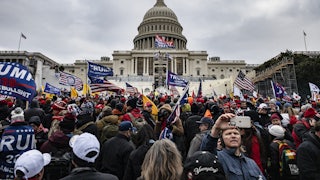For decades, the executive class has been cutting itself a larger and larger piece of the American pay pie, leaving everyone else with a thinner slice, with devastating consequences for social stability and financial security.
Top-heavy pay is a major factor in America’s worsening income inequality and the social tensions it creates. It’s a problem that we, as members of a democratic society, can choose to do something about. But before showing how closely tied the stock market and executive class pay are, and how Congress can act, let’s review a few shocking pay numbers.
In 2020, a stunning 82 percent of all the pay raises in America went to the 184,631 workers in the executive class, I calculated from official government pay data, which I slice and dice each year. This data is not from surveys, which can be unreliable, or economic estimates. It’s from hard numbers from the W-2 wage reports that all 167.6 million people with paid work received for 2020. Our government adds the W-2s up to the penny.
Collectively, the executive class, which makes up just 0.1 percent of all workers, is pocketing nearly seven cents out of each dollar in the pay pie, up from a nickel three decades ago. In 2020, only one in 907 workers was in this exclusive pay club.
And what of the 99.9 percent of workers who earned less than $1 million in 2020?
For full-time workers making up to $250,000, the median pay raise—half got more, half got less—was just $26. That’s 50 cents a week, a tad more than a penny an hour in inflation-adjusted terms.
The 2021 pay story was not quite as awful. The executive class collected 29 percent of all the pay increases in America—a much smaller share than in 2020, but still wildly disproportionate to the growth of the economy and the overall cost of business. This thin and richly compensated slice of the workforce, some 237,000 workers, made as much money in 2021 as the bottom 60 million workers.
As for the size of pay raises, the gain was a rich pile of cream atop the pay pie. The average executive class pay increase was $840,000. For full-time workers making up to $250,000 a year the average pay hike was just $1,600.
Finally, at the very, very, very top, pay ballooned in 2021. The highest-paid 506 employees in America averaged $151 million in 2020, up from the $95 million average in 2020 when 358 workers made it into the pay stratosphere.
But then, in 2022—everything changed. That’s the good news, because it shows what can be done to distribute the fruits of the American economy based more on contribution and less on power and control of corporate executives. In that year, executive class pay plummeted almost 21 percent, as 7,000 people fell out of the executive class.
What explains this sharp reversal in a decades-long trend toward more and more for those at the very top? It would be nice to credit it to something the Biden administration did, but the answer is more prosaic: The stock market fell by 20 percent in 2022, almost the same percentage drop as executive class pay. It makes sense because while most workers get paid by the hour or earn an annual salary, the executive class collects most of its pay in stock options.
An option is the right to buy a stock at today’s price at a future date, usually within 10 years. If a share is worth $10 when an option is given to an executive and later trades at $50 the executive can pocket $40.
Stock options are the reason for the explosion in executive pay over the last three decades or so. Back in 1993, at the urging of Minnesota Democratic Representative Martin Olav Sabo, Congress capped the maximum executive salary that could be deducted on a corporate tax return at $1 million. Companies could pay more, and some did, but they couldn’t get a tax deduction for the extra salary. The cap has since been adjusted for inflation, something Congress doesn’t do for many other sections of the tax code. This limit on deducting salaries was a factor in the growing use of stock options to pay the executive class.
In theory, paying in stock options aligns the interests of executives and shareholders. But when executives exercise their options and sell their shares, their interests become less aligned with shareholders.
Even those in the executive class and their advisers know that those at the top get paid more than their skills are worth. I’ve had Fortune 500 CEOs and executive pay consultants acknowledge this to me in interviews when I was exposing hidden aspects of executive pay in The New York Times in the 1990s.
So: What can be done about all this? Here’s what people can press their representatives in Washington to do to rein in executive pay packages.
First, demand that Congress restore the pre–Reagan administration policy making stock buybacks illegal. Buybacks are a form of market manipulation. Without buybacks, executive pay packages will be slimmed down, and more corporate profits will be reinvested in the business—paying bigger dividends or increasing worker pay, both of which are pro–economic growth.
Second, demand Congress require that the price to exercise stock options must be the current price of shares plus the increase of the overall stock market. That way executives don’t get a free lunch from a general increase in stock values. For example, imagine that executive with a $10 option. She makes a $40 profit by selling out at $50. However, if the overall market doubled in value, then the executive would pay $20 per share when exercising the option, and the profit would be $30 before taxes. Ending buybacks would help keep stock prices more in line with corporate profits, not market manipulations.
Third, Congress could impose higher marginal tax rates on salaries in the millions, tens of millions, and hundreds of millions of dollars. This year, the top federal income tax rate of 37 percent starts at $609,350, roughly the threshold for joining the 1 percent. That’s a lot of money, but not to those in the $50 million-and-up executive pay class. The top 506 executive class members in 2021 made $609,350 in less than two days, yet they pay taxes at the same rate as, or at an even a lower rate than, a two-income couple who worked all year to make that amount. That’s because many executives get “qualified” options. Those are taxed at just 15 percent—and that tax applies only when the stock is sold, not when the option is exercised.
Adding progressively higher tax brackets at $1 million, $5 million, $10 million, $25 million, and so on would bring more tax revenue to our government, which is awash in the red ink of annual budget deficits. That would also foster fairness in how the national pay pie is sliced up. So would taxing all options at the same rate as cash pay and imposing the tax immediately when the options are exercised.
If Congress raised the highest income tax rate back to the 70 percent in effect when Ronald Reagan took office, then corporate directors who set executive pay would be faced with questions from shareholders about the best use of company funds. Restoring the pre-Reagan tax rates for super–high pay executive class members would mean that each additional dollar a company pays top executives would net just 30 cents, while our government would get more than twice as much in taxes. Shareholders could challenge gigantic pay packages as wasting corporate assets, reducing funds available to reinvest in the business to make it grow or to pay dividends. Both American business law and the courts view wasting corporate assets as serious misconduct, though the outcome of such challenges is far from certain.
Is paying $151 million, on average, to top executives necessary? Would they work less if paid, say, $15 million a year? Basic pay theory holds that employers should pay the smallest amount that will keep good workers from leaving. But it’s an open secret among the senior executive ranks that the game is rigged to pay CEOs and other very top executives every dollar they can get away with at all but a few companies.
It’s important to distinguish here between company founders who ought to make as much as their ideas are worth in the marketplace and executives, even CEOs, who are just workers. Extraordinarily well paid for sure, but still just workers.
Voters should ask congressional, senatorial, and presidential candidates why mere managers—and that’s what executives are—should be rewarded like they founded a company or invented a new device. Congress can shape our tax laws to continue favoring inventors and founders while treating the executive class like what they are—workers. Congress has imposed strict rules on compensation of nonprofit executives, whose pay is limited to a narrow range based on others in similar positions. Nonprofit pay, Congress requires, must be “reasonable and not excessive.”
There are other tools Congress could adopt to rein in executive pay. But nothing will happen unless people start talking about these issues, telling others about outrages like the 82 percent of 2020 pay raises going to the million-and-up pay club.






